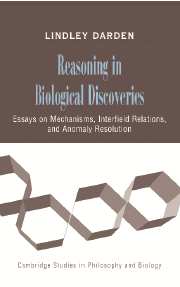 Reasoning in Biological Discoveries
Reasoning in Biological Discoveries Book contents
- Frontmatter
- Contents
- Long Contents
- List of Figures
- List of Tables
- Acknowledgments
- Introduction
- PART I BIOLOGICAL MECHANISMS
- 1 Thinking About Mechanisms with Peter Machamer and Carl F. Craver
- 2 Discovering Mechanisms in Neurobiology: The Case of Spatial Memory with Carl F. Craver
- 3 Strategies in the Interfield Discovery of the Mechanism of Protein Synthesis with Carl F. Craver
- 4 Relations Among Fields: Mendelian, Cytological, and Molecular Mechanisms
- PART II REASONING STRATEGIES: RELATING FIELDS, RESOLVING ANOMALIES
- PART III DISCOVERING MECHANISMS: CONSTRUCTION, EVALUATION, REVISION
- Bibliography
- Index
- References
2 - Discovering Mechanisms in Neurobiology: The Case of Spatial Memory with Carl F. Craver
Published online by Cambridge University Press: 31 August 2009
- Frontmatter
- Contents
- Long Contents
- List of Figures
- List of Tables
- Acknowledgments
- Introduction
- PART I BIOLOGICAL MECHANISMS
- 1 Thinking About Mechanisms with Peter Machamer and Carl F. Craver
- 2 Discovering Mechanisms in Neurobiology: The Case of Spatial Memory with Carl F. Craver
- 3 Strategies in the Interfield Discovery of the Mechanism of Protein Synthesis with Carl F. Craver
- 4 Relations Among Fields: Mendelian, Cytological, and Molecular Mechanisms
- PART II REASONING STRATEGIES: RELATING FIELDS, RESOLVING ANOMALIES
- PART III DISCOVERING MECHANISMS: CONSTRUCTION, EVALUATION, REVISION
- Bibliography
- Index
- References
Summary
INTRODUCTION
This chapter is about discovery in neurobiology; more specifically, it is about the discovery of mechanisms. The search for mechanisms is widespread in contemporary neurobiology, and, understandably, the character of this product shapes the process by which mechanisms are discovered. Analyzing mechanisms and their characteristic organization reveals constraints on their discovery. These constraints reflect, at least in part, what it is to have a plausible description of a mechanism. These constraints also highlight varieties of evidence that both guide and delimit the construction, evaluation, and revision of such plausible descriptions.
The central example in the following discussion is the continuing discovery of the mechanism of spatial memory. Spatial memory, roughly speaking, is the ability to learn to navigate through a novel environment. The mechanism of spatial memory is multilevel, and recently an integrated sketch of the mechanism at each of these levels has started to emerge. Even though this sketch is far from complete at this time, the example offers a glimpse at the kinds of constraints that are delimiting and guiding this gradual and piecemeal discovery process.
This chapter opens with an analysis of mechanisms, discussing their components and their characteristic spatial, temporal, and multilevel organization. Mechanisms are often discovered gradually and piecemeal. The second section introduces conventions for constructing incomplete and abstract descriptions of mechanisms (namely, the mechanism sketch and the mechanism schema) and for describing the constraints under which the gradual and piecemeal discovery of these sketches and schemata proceeds.
- Type
- Chapter
- Information
- Reasoning in Biological DiscoveriesEssays on Mechanisms, Interfield Relations, and Anomaly Resolution, pp. 40 - 64Publisher: Cambridge University PressPrint publication year: 2006


